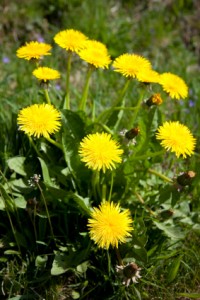Those pesky, but delightfully bright flowers that pop up all over your lawn are tremendously useful. You can eat every part of the plant, roots, leaves, and flowers and they are good for you. Dandelions are a flowering plant that many of us have learned to label as a weed. It is native to North America and Europe. There are two species: Taraxacum officinale and Taraxacum erythrospermum. Both are completely edible and nutritious.
 Although the name may seem to describe the bright yellow flower that resembles a lion’s mane, dandelion actually comes from the French name, dent de lion. This means “tooth of the lion” and refers to the toothed nature of the dandelion’s leaves. Another name for dandelions in various European languages is “wet the bed”. The not so nice name comes from the fact that the roots are diuretics.
Although the name may seem to describe the bright yellow flower that resembles a lion’s mane, dandelion actually comes from the French name, dent de lion. This means “tooth of the lion” and refers to the toothed nature of the dandelion’s leaves. Another name for dandelions in various European languages is “wet the bed”. The not so nice name comes from the fact that the roots are diuretics.
Good, scientific studies of dandelions and their health and medicinal benefits are few and far between. However, people in Europe have been using the plant for hundreds of years for its nutritional value and for treating a variety of ailments. In fact, the name Taraxacum officinale means “the official remedy for disorders.” Before you use dandelion in any medical way, consult with your doctor to be sure you will not experience side effects or complications.
The Health Benefits
Dandelion leaves, in particular are chock full of vitamins and minerals, but there are also specific health benefits that many people claim come with eating the dandelion. Eating dandelions is very safe, as long as you are careful not to use those that have been in contact with pesticides, herbicides, or fertilizers. Supplements are another story. Before you use any supplements, especially in a child, consult with a doctor.
- Diuretic. One of the traditional uses of dandelion roots, leaves, and flowers is as a diuretic. Consuming the plant, especially as a tea, will increase the amount of urine you produce. This can help with any health issues that can benefit from ridding the body of excess fluids such as high blood pressure, liver problems, and bloating.
- Appetite stimulant. Dandelion leaves and flowers, both dried and fresh, act as an appetite stimulant and may also help to improve an upset stomach.
- Laxative. Dandelion roots can act as a mild laxative and may improve digestion.
- Blood sugar. Some early studies using dandelions and animals have found that eating the plant can help to normalize levels of blood sugar. The tests are not conclusive, however, and no studies have been done on people. Similar studies indicate that dandelions may lower bad cholesterol in the blood and raise good cholesterol.
- Nutrition. Perhaps the best reason to eat dandelions is the abundance of nutrients present in them. The greens contain significant amounts of fiber, protein, vitamins A, B1, B2, B6, C, E, and K, folic acid, calcium, iron, magnesium, manganese, potassium, and zinc.
Learn How To Make Your Own Emergency
Remedies For Use In Any Survival Situation …
The Leaves
The leaves are the most nutritious part of the dandelion plant and the easiest to tackle for dandelion beginners. They can be eaten as you would eat most other types of greens. The best way to get the tastiest dandelion greens is to collect the young leaves in the spring. If you use greens after the flower stalk grows tall and the flower opens, they will be very bitter. Harvest the youngest leaves from each plant, which are the ones on the inside of the ring of greens. The leaves will keep for a day or two, but they are best eaten immediately.
Make sure you wash your greens thoroughly to remove and dirt, grit, and insects. If you got very young, early spring leaves, you can eat them raw in a salad. They make a tasty addition and add a little kick to an otherwise plain salad. You can also cook your greens. They can be steamed, sautéed, or boiled, but the best way to cook greens is a combination of all three. Start by sautéing the greens in a hot pan with oil with garlic and onions. After a few minutes, add stock to the pan to a depth of about a half inch. Put the lid on the pot, slightly askew and let the greens steam/boil until they are tender and the liquid has decreased a little bit. Add salt, pepper, and a splash of vinegar and serve as a side dish or mixed into a pasta dish.
The leaves can also be made into a nutritious and healthful tea. Use about two tablespoons of chopped fresh leaves or one teaspoon of dried leaves in one cup of hot water. Steep for a few minutes and sweeten with honey if desired. You can also mix the leaves with other herbs, like mint, to change the flavor.
The Flowers
When harvesting the flowers to eat, simply pop the bloom off of the stalk. To use, you want to remove the flowers from the green base, which is too bitter for most people’s taste. A couple of tablespoons of the flowers in hot water make a tasty tea that is also nutritious.
Perhaps the most common culinary use for the flowers is dandelion wine. The wine can be made using the entire flower or just the yellow part to make the flavor less bitter. A general recipe for dandelion wine requires the flowers, brewer’s yeast, water, and sugar. You can also add in flavorful additions like fruit juices, citrus zests, and ginger.
The first step is to soak the flowers in water for a few days. For one batch, use about two quarts of flowers. Drain the water and add the flowers to four quarts of water. Add in any flavorings. A few tablespoons of each juice and zest that you want to use will be sufficient. Add six cups of sugar. Boil the mixture for an hour. After it has cooled strain it through coffee filters so that you have just the liquid. Stir one package of brewer’s yeast into the liquid, cover it, and let it stand overnight.
Pour your mixture into bottles and store for fermentation. This process takes about three weeks and should be done in the dark. To keep out unwanted ingredients, stretch a balloon with a couple of holes poked in it over the top of each bottle. After fermenting, cork your bottles and store them for up to a year before drinking.
The Roots
The roots of the dandelion, like the leaves are chock full of nutrients and can be used as a diuretic. The most popular way to use the roots is to make a hot drink that is an excellent substitute coffee. If you love your coffee, but want something with more nutrition and less caffeine, give this a try. Harvest roots in the spring for the optimum amount of nutrients.
Once you have your roots, clean them very well to remove all dirt. Cut the cleaned roots into small, one-inch chunks. Put the roots in a blender or food processor to get a coarsely-ground consistency. You can also grind them after roasting. To roast, spread the roots out on a cookie sheet to a depth of about a half inch. Roast at 250 degrees for approximately two hours. Leave the door open during the process, so that the roots can dry. Stir often during the two hours.
Once your roots are roasted and cooled, you can use them and store any extra in airtight containers. To make the coffee, use a tablespoon of roots to a cup of water and steep like tea. Alternatively, you can grind the roots further to get a powder, which you can then use in your coffee pot. Flavor and enjoy just as you would a cup of coffee.
 Off The Grid News Better Ideas For Off The Grid Living
Off The Grid News Better Ideas For Off The Grid Living




